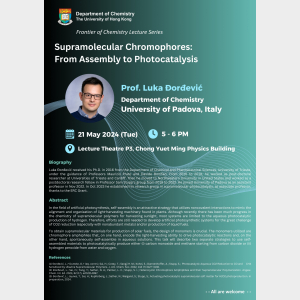| Date | 20 May 2024 |
| Time | 11:00 am - 12:00 noon |
| Venue | Lecture Theatre P1, Chong Yuet Ming Chemistry Building |
| Speaker | Prof. Xinliang Feng |
| Institution | Max Planck Institute of Microstructure Physics, Technische Universität Dresden |







Title:
Beyond Layers: Unveiling the Potential of Organic 2D Crystals in Emerging Material Science
Schedule:
Date: 20th May, 2024 (Monday)
Time: 11 am - 12 noon (HKT)
Venue: Lecture Theatre P1, Chong Yuet Ming Chemistry Building
Speaker:
Biography:
Prof. Feng is a director of the Max Planck Institute of Microstructure Physics and the head of the Chair of Molecular Functional Materials at Technische Universität Dresden. His current scientific interests include synthetic methodology for new-type of polymers, organic and polymer synthesis, interfacial chemistry, supramolecular chemistry of π-conjugated system, bottom-up synthesis of carbon nanostructures and graphene nanoribbons, 2D polymers and supramolecular polymers, as well as 2D carbon-rich conjugated polymers for opto-electronics, spintronics, molecular quantum and computing devices, electrochemical exfoliation of 2D crystals, graphene and 2D materials for energy storage and conversion, new energy devices and technologies. He has published more than 725 research articles which have attracted >110000 citations with H-index of 165 (Google Scholar).
He has been awarded several prestigious prizes such as IUPAC Prize for Young Chemists (2009), European Research Council (ERC) Starting Grant Award (2012), Journal of Materials Chemistry Lectureship Award (2013), ChemComm Emerging Investigator Lectureship (2014), Fellow of the Royal Society of Chemistry (FRSC, 2014), Highly Cited Researcher (Thomson Reuters, 2014-2021), Small Young Innovator Award (2017), Hamburg Science Award (2017), EU-40 Materials Prize (2018), ERC Consolidator Grant Award (2018). He is a member of the European Academy of Sciences (2019), member of the Academia Europaea (2019), member of the German Academy of Science and Engineering (acatech, 2021), and member of the German Academy of Sciences (Leopoldina, 2024). He is an Advisory Board Member for Advanced Materials, Chemical Science, Journal of Materials Chemistry A, ChemNanoMat, Energy Storage Materials, Small Methods, Chemistry -An Asian Journal, Trends in Chemistry, etc. He is the Head of ESF Young Research Group "Graphene Center Dresden", Working Package Leader of WP Functional Foams & Coatings for European Commission’s pilot project “Graphene Flagship”, and spokesperson for the DFG Collaborative Research Center for the Chemistry of Synthetic 2D Materials (2020-).
Abstract:
Organic 2D crystals with extended in-plane conjugation and strong interlayer coupling have emerged as a distinctive class of layered materials characterized by unique electronic structures and exotic physicochemical phenomena, with significant application potential. A widely employed approach for synthetic access to these precision materials is bottom-up synthesis. This encompasses the creation of single-layer to few-layer 2D polymers/supramolecular polymers, 2D conjugated polymers or covalent-organic frameworks, and 2D conjugated metal-organic frameworks. A key chemical challenge is to achieve controlled 2D polymerization in two distinctive directions under thermodynamic/kinetic control in solution, in the solid state, or at the surface/interface. In the first part of my talk, I will present novel 2D polymerization methods together with design strategies aimed at achieving efficient 2D conjugation in specific 2D conjugated polymers, such as 2D poly(arylenevinylene)s and 2D poly(benzimidazobenzophenanthroline)-ladder-type structures. These 2D conjugated polymers provide a material platform for realizing high intrinsic carrier mobilities, which is crucial for future organic opto-electronics and spintronics. In the next part, I will present our recent progress in 2D conjugated metal-organic framework materials, highlighting their applications in MOFtronics and beyond. In the following part, I will discuss on-water surface chemistry as a potent synthetic platform for organic 2D crystals and their van der Waals heterostructures, leveraging water-surface confinement and enhanced chemical reactivity and selectivity. A major focus will be on the surfactant-monolayer-assisted interfacial synthesis (SMAIS) method, which is now known for its high efficiency in the programmable arrangement of precursor monomers on the water surface and subsequent controlled 1D/2D polymerization. The distinct 2D crystal structures that offer tailorable conjugated building blocks and conjugation lengths, tunable pore sizes and thicknesses, and remarkable electronic structures, make these materials highly promising for various applications in electronics, optoelectronics, and spintronics. Other physicochemical phenomena and application potential of organic 2D crystals, such as in membranes and emergent energy devices, will also be discussed.
- ALL ARE WELCOME -
